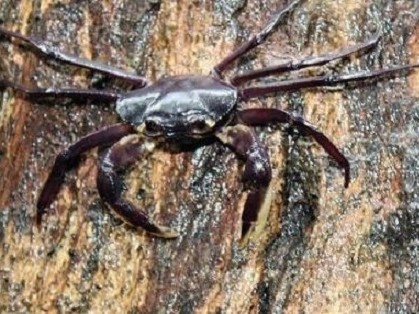
 The stuff of nightmares? A tree dwelling crab is a reality.
The stuff of nightmares? A tree dwelling crab is a reality.
The Western Ghats in southern India are well known for being a biologically diverse region, containing the country’s largest populations of Asian elephant, Bengal tiger, lion-tailed macaque and sloth bears. Now, a new species has been discovered native to the area — a long-legged, tree dwelling crab named the Kani maranjandu, the first arboreal crab to be found.
Running along the west coast of India in soft undulating hills are the Western Ghats mountains. Older than the Himalayas and ecologically rich, the area has been named a UNESCO World Heritage Site as well as one of the world’s eight hottest “biological hotspots” for the sheer range and diversity of flora and fauna endemic to the area. And while humanity is aware of some of the more dramatic species dwelling within the Western Ghats such as the Bengal tiger, the Indian parakeet and the Indian leopard, there is still much wildlife therein that remains undocumented by science, including (up until now) the Kani maranjandu.
A habitually difficult-to-spot creature, a two-year survey of freshwater crabs in the region began in 2014 with reported sightings of these crabs with elongated legs but it wasn’t until two years later on September 5, 2016, when researchers, helped by local tribespeople known as the Kanikkaran (or Kani), succeeded in capturing a female specimen and then later an adult male.
The dark purple-hued crab is “substantially different from all congeners,” say the researchers in their study, published in the Journal of Crustacean Biology, most notably due to its unique carapace and “conspicuously elongated ambulatory legs.”
Already, though, the researchers can see that the Kani maranjandu might serve as an ecological indicator for the region.
“As water holding hollows in large trees are essential for the survival of this unique species, the discovery also stress the need for conservation of large trees in the degraded forest ecosystems of the Western Ghats,” said Dr. Biju Kumar of the Department of Aquatic Biology and Fisheries at the University of Kerala in India, in a statement. “It also highlights how little we know about the actual biodiversity that resides in these forests and the efforts that must still be made to find and study the many undoubted new species that still live there.”
New crab species are being discovered by the leg-ful recently, with another terrestrial crab just identified along the eastern coast of Hong Kong. Less than a centimetre long, the tiny Haberma tingkok was found walking along the bark of tree branches at low tides. Meanwhile, earlier this year, two more crab species were identified from the coral reefs near the island of Guam in the western Pacific.
As far as land crab species go, however, the largest known (so far) is the coconut crab, found widely along islands of the Indian and Pacific Oceans. Hunted by humans out of existence in some regions, the coconut crab can grow up to one metre in length and weigh up to 4.1 kg.
Worldwide, there are over 4,500 species of marine, freshwater and terrestrial crabs. In Canada, the East Coast snow crab and West Coast Dungeness crab are two of the more sought-after varieties for human consumption.
Leave a Reply
You must be logged in to post a comment.




 Share
Share Tweet
Tweet Share
Share




Comment